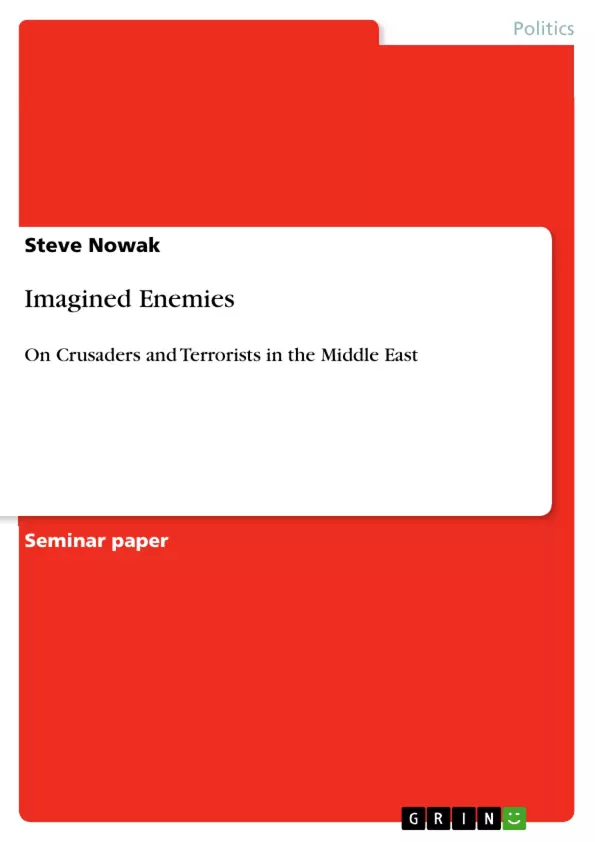In September 2001, shortly after the terrorist attacks on America, President George W. Bush announced his “Crusade” against terrorism - a Crusade that was aimed mainly at Islamic fundamentalists. One Millennium after the first Crusades, that conflict seemed still going on and the connection to that fateful day in September 2001 was drawn easily. The fight had been going on since the first expansion of Islam into the former Christian world.
An everlasting conflict between Christians in the West and Muslims in the East seems so obvious that we take it for self-evident when we perceive our political world. Authors have written and modified it repeatedly. Not long ago, Bernard Lewis wrote his Islam and the West telling us about the history of these cultures as a history of military conflict.
One more famous book takes that approach to take a look at the recent development in world politics and predict its Clash of Civilizations. Huntington shows the post-Cold War world by explaining global politics along cultural lines. One of the most important of these lines is, not surprisingly, the one between the Islamic and the Western Civilizations.
But what if we take a closer look on what appears to be behind the ambiguous history of Crusades and Holy Wars. Are there perhaps more sophisticated explanations. We have to differentiate the motives for the main campaigns in an assumed “continuous conflict.” Therefore we will see over the Crusades, the fierce war at the front between Christendom and Islam under Ottoman rule and finally the modern antagonisms to verify or falsify that theory of a causally determined cultural conflict.
Inhaltsverzeichnis (Table of Contents)
- Introduction: An Assumed Tradition
- The Ancient Conflicts
- The Crusades: 'Deus lo vult!'
- The Ottoman Empire and Habsburg: Crescent and Cross
- The Modern Conflicts
- The Middle East: Defeat of the Ottomans and Inventing the Mandates
- The Muslims and Israel: Androcles against the Lion
- Conclusion: Intervention and Demonization
Zielsetzung und Themenschwerpunkte (Objectives and Key Themes)
This paper analyzes the historical and contemporary conflicts between the West and the Middle East, particularly focusing on the concept of "Crusades" and its implications in shaping perceptions of these conflicts. It aims to provide a nuanced perspective on the origins and complexities of these tensions, examining both historical and contemporary narratives.- The construction and perception of "enemies" in the context of the Crusades and modern conflicts.
- The role of religion and cultural differences in shaping historical and contemporary conflicts.
- The evolution of the "Crusade" narrative from the medieval period to the contemporary era.
- The influence of Western imperial ambitions and the invention of mandates in the Middle East.
- The impact of historical narratives on contemporary political discourse and policies.
Zusammenfassung der Kapitel (Chapter Summaries)
- Introduction: An Assumed Tradition: This section introduces the historical context of the "Crusades" narrative and its persistence in shaping perceptions of Western-Middle Eastern conflicts. It highlights how the concept of a continuous conflict between Christian and Muslim civilizations has been perpetuated by influential authors like Bernard Lewis and Samuel P. Huntington.
- The Crusades: 'Deus lo vult!': This chapter explores the origins of the Crusades, focusing on the historical context, motivations, and consequences of these religious wars. It examines the role of the Byzantine Empire, the Church, and the influence of Christian ambitions in the eleventh century.
- The Ottoman Empire and Habsburg: Crescent and Cross: This section analyzes the conflicts between the Ottoman Empire and European powers, particularly the Habsburg dynasty. It delves into the dynamics of religious and cultural clashes during this period.
- The Middle East: Defeat of the Ottomans and Inventing the Mandates: This chapter examines the impact of the Ottoman Empire's decline on the Middle East and the subsequent imposition of Western mandates by European powers. It explores the political and social ramifications of this period.
- The Muslims and Israel: Androcles against the Lion: This chapter focuses on the complex and multifaceted conflict between Muslims and Israel. It investigates the historical background of the conflict and the role of external forces in its development.
Schlüsselwörter (Keywords)
The primary focus of this paper is on the historical and contemporary conflicts between the West and the Middle East. This work explores the concept of "Crusades" and its influence on perceptions of these conflicts. Key themes include religion, culture, historical narratives, imperial ambitions, and the construction of enemies. The paper examines the complex and dynamic relationships between the two regions, aiming to provide a nuanced understanding of the underlying causes and implications of these ongoing tensions.- Quote paper
- Magister Artium Steve Nowak (Author), 2010, Imagined Enemies, Munich, GRIN Verlag, https://www.grin.com/document/147774



